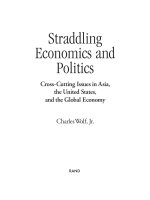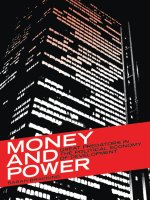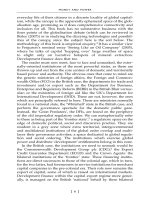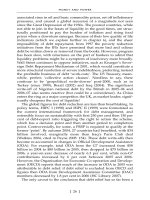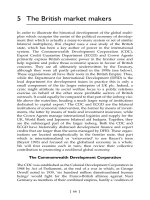Zombie banks how broken banks and debtor nations are crippling the global economy
Bạn đang xem bản rút gọn của tài liệu. Xem và tải ngay bản đầy đủ của tài liệu tại đây (2.24 MB, 148 trang )
Table of Contents
Cover
Additional Praise for Zombie Banks
Bloomberg Press
Title page
Copyright page
Dedication
Foreword
Preface
Cast of Characters
Chapter 1 Zombies in Our Midst
The Art of Keeping Zombies Alive
Kicking the Can Down the Road
Zombies and Lost Decades
Chapter 2 Lessons Not Learned
The U.S. Thrift Crisis
Japan’s Lost Decade
Delaying the Fix Increases Costs
Chapter 3 Europe’s Sovereign Blues
When PIGS Fly
Zombies in the Pigsty
Putting Lipstick on a Pig
Spain’s Zombies
When PIGS Stop Flying
Chapter 4 Germany’s Untouchable Zombies
Landesbanks in the Land of Banks
Politics and Banking
Cheap Money, One Last Time
Even the EU Can’t Shut Them Down
Irish Connection 2.0
Other German Zombies
Broken Models, Suffering PIGS
Chapter 5 Ireland’s Zombies Bring the House Down
The Celtic Tiger’s Final Sprint
The Guarantee from Hell
You Can’t Burn the Creditors
Not So Innocent EU
Zombies No More?
The Crippled Housing Market
Will the Tiger Make It?
Chapter 6 The Reincarnation of Iceland’s Banks
The Land of Fire and Ice Catches Fire
The Unheeded Fire Alarm
Devaluation No Panacea
Good Bank–Bad Bank, Sort of . . .
The Icesave Saga
Reincarnation and Recovery
Chapter 7 U.S. Zombies on IV Drip
Saving Citi—Again
A Snake Gobbling Up Poisoned Rats
“Pretend and Extend”
Turn a Blind Eye to Weak Capital
Bad Bank or Just an Administrative Concept?
Tenuous Existence
Chapter 8 The Fight to Rein in the Banks
Missed Opportunity
Volcker’s Friends and Enemies
Fear of Lincoln’s Amendment Helps Volcker
The Republican Toughie
Finding Ways to Skinny the Banks
The Farm Boy versus Goliath
Never-Ending Assault
Chapter 9 To Foreclose or Not to Foreclose?
Protecting Home Equity Loans
Banks Wave the Moral-Hazard Card
Principal Reduction: The Bogeyman
Servicing Costs Rise
Crappy Mortgages Returned
When the Levees Are Opened
Chapter 10 Bigger Banks, More Derivatives, Higher Risk
Banks Get Help in Their Derivatives Fight
Unaligned Interests of Bondholders
Too Interconnected to Fail
Chapter 11 Killing Zombies and Preventing Their Return
Who Bears the Cost?
The Fallacy Over Capital
Breaking Up the Big Boys
Coming to Terms with Reality
Epilogue
About the Author
Index
Additional Praise for Zombie Banks
“Yalman Onaran’s analysis is dead-on. So is his imagery of the dead banks walking among us,
stalking and killing the wobbly post-2008 recovery. Zombie Banks clearly and scarily puts together
all the pieces that explain a financial world again falling apart. Onaran calls out the culpable, from
Wall Street’s toady Tim Geithner to Ireland’s clueless bankers, and writes so lucidly as to render a
complex mess understandable.”
—John Helyar, co-author of Barbarians at the Gate
“This book does an excellent job of pointing out the administrative and political pressures that are
rampant. I like the contrast used to make the point that Iceland avoided the major errors. I’ve always
recommended more capital for the banks as the best way out; so does Onaran. The only way is to
announce that we will not bail out any firm at any time; that will change their attitude toward more
capital. Higher capital requirement puts the risk decision on management and stockholders, where it
belongs.”
—Allan Meltzer, author, A History of the Federal Reserve, and professor, Carnegie Mellon
University
“Zombie Banks, like the movie Zombieland, is a fun romp—until you realize this is not fiction.
Onaran effectively expands Ed Kane’s thesis from the Thrift Crisis, when only a few U.S. institutions
were ‘too big to fail,’ and shows how the program of declaring the end of insolvency by merely
refusing to recognize its existence has grown popular, worldwide. Of course, Onaran can’t yet tell us
the end of the story, but we can surmise that the longer the trend continues the worse the fallout will
be.”
—Joseph Mason, professor, Louisiana State University
Since 1996, Bloomberg Press has published books for financial professionals, as well as books of
general interest in investing, economics, current affairs, and policy affecting investors and business
people. Titles are written by well-known practitioners, BLOOMBERG NEWS ® reporters and
columnists, and other leading authorities and journalists. Bloomberg Press books have been translated
into more than 20 languages.
For a list of available titles, please visit our Web site at www.wiley.com/go/bloombergpress.
Copyright © 2012 by Yalman Onaran. All rights reserved.
Published by John Wiley & Sons, Inc., Hoboken, New Jersey.
Published simultaneously in Canada.
No part of this publication may be reproduced, stored in a retrieval system, or transmitted in any form
or by any means, electronic, mechanical, photocopying, recording, scanning, or otherwise, except as
permitted under Section 107 or 108 of the 1976 United States Copyright Act, without either the prior
written permission of the Publisher, or authorization through payment of the appropriate per-copy fee
to the Copyright Clearance Center, Inc., 222 Rosewood Drive, Danvers, MA 01923, (978) 750-8400,
fax (978) 646-8600, or on the Web at www.copyright.com. Requests to the Publisher for permission
should be addressed to the Permissions Department, John Wiley & Sons, Inc., 111 River Street,
Hoboken, NJ 07030, (201) 748-6011, fax (201) 748-6008, or online at
/>Limit of Liability/Disclaimer of Warranty: While the publisher and author have used their best efforts
in preparing this book, they make no representations or warranties with respect to the accuracy or
completeness of the contents of this book and specifically disclaim any implied warranties of
merchantability or fitness for a particular purpose. No warranty may be created or extended by sales
representatives or written sales materials. The advice and strategies contained herein may not be
suitable for your situation. You should consult with a professional where appropriate. Neither the
publisher nor author shall be liable for any loss of profit or any other commercial damages, including
but not limited to special, incidental, consequential, or other damages.
For general information on our other products and services or for technical support, please contact
our Customer Care Department within the United States at (800) 762-2974, outside the United States
at (317) 572-3993 or fax (317) 572-4002.
Wiley also publishes its books in a variety of electronic formats. Some content that appears in print
may not be available in electronic books. For more information about Wiley products, visit our web
site at www.wiley.com.
Library of Congress Cataloging-in-Publication Data:
Onaran, Yalman, 1969–
Zombie banks : how broken banks and debtor nations are crippling the global economy / Yalman
Onaran.
p. cm. — (Bloomberg Press)
Includes index.
ISBN 978-1-118-09452-5 (cloth); ISBN 978-1-118-18533-9 (ebk);
ISBN 978-1-118-18532-2 (ebk); ISBN 978-1-118-18531-5 (ebk)
1. Debts, External—History—21st century. 2. Banks and banking—History—21st
century. 3. Economic history—21st century. I. Title.
HG3891.5.O53 2011
332′.042—dc23
2011032158
To Dad, who said he bargained with the Grim Reaper to delay the day until this book’s
publication, and
To Mom, whose habit of playing the devil’s advocate in debates taught me to consider opposing
views more easily.
Foreword
Many books have been written about the financial crisis. They are, perhaps, getting better with age.
Perspective improves as time passes. Economic truisms that were obfuscated in the informational fog
that surrounded the financial crisis are coming back into focus as the fog clears.
In the years leading up to the crisis, we somehow lost our way. We confused “free markets” with
“free-for-all” markets. We transitioned from a society that valued hard work and entrepreneurship to
one that worshipped housing speculation and financial arbitrage.
In the fall of 2008, we got our comeuppance, as an economy based on over-leveraged consumers,
inflated real estate prices, and artificial derivatives products finally collapsed.
The Great Recession was not the product of an inevitable business cycle. It was caused by the
excessive risk taking of a number of large financial institutions. Investors and creditors supported
them, notwithstanding their high flying ways, because of the perception that the government would not
let them fail. The “smart money” played the system.
And the smart money was right.
Instead of using the crisis as an opportunity to clean out the system, we bailed out most of the
inefficient institutions and left the bad assets to rot on their balance sheets. Within a year, those who
had been bailed out were paying themselves bonuses while many of the bailers were losing their
houses, their jobs, or both.
To be sure, some of the stabilization measures undertaken in the United States were dictated by
limitations on the legal tools that were available to close down failing institutions in an orderly way.
And notwithstanding the shortcomings of our efforts, we did force our banks to raise significant
amounts of new capital and dramatically reduce reliance on short-term funding. As a consequence,
U.S. banks are much more stable today than their European counterparts.
But as Yalman Onaran points out in this highly readable book, by bailing out mismanaged
institutions, we repeated the mistakes of Japan’s “lost decade” and of our own savings-and-loan
debacle.
By propping up failing firms, we penalized the well-managed institutions and interfered with the
basic functioning of the market. We cannot rely on our capitalist system to allocate resources for their
most productive use unless we let the inefficient or mismanaged fail.
We did not force our financial institutions to shed their bad assets and recognize the losses. And the
lingering uncertainty about the true extent of those losses makes previously profligate management
more risk averse in an economy where prudent risk taking and lending are most needed, particularly
by small businesses.
Unfortunately, governments around the globe continue to nurture and support a bloated financial
sector built around an unsustainable model. In the United States, we guarantee their mortgages and
subsidize their leverage. So beholden is Washington to the big financial players that it can’t even
make hedge fund managers pay the same tax rates as the rest of us.
To be sure, a healthy financial sector and recovering housing market are essential to our economic
future, and not all financial institutions contributed to the crisis.
But we have to accept the fact that financial services and the housing bubble they fueled became a
disproportionate part of our global economy and a disproportionate influence over governments
throughout the world. Instead of their traditional role of supporting the credit needs of the real
economy, financial services became an end to themselves.
The task at hand is to determine how, in defining our regulatory and fiscal priorities, we can
downsize the financial sector over time and reallocate resources to areas that will generate lasting
jobs and get us back onto a sustainable economic path.
It is essential that we maintain course on the Basel III agreements to substantially increase both the
quality and quantity of capital held by internationally active financial institutions, as well as the
agreement to impose an additional capital surcharge on the most systemically important. Stronger
capital requirements for financial behemoths are the most direct way to constrain their size and
imprudent risk taking. Yet, as this book documents, those hard won agreements are already under
political attack.
Ironically, the political debate over how to restart the global economy is devoid of any
acknowledgement of the role a bloated financial services industry plays in impeding growth. Until
government policymakers come to grips with the basic economic truths reflected in this book, our
road to recovery will be a very slow and costly one.
SHEILA BAIR
August 2011
Preface
The global financial crisis started much earlier for me than for most other people. I was a finance
journalist covering Bear Stearns and Lehman Brothers for Bloomberg News. The problems at Bear
Stearns surfaced in June 2007, and the bad news didn’t let up for one minute until the Wall Street
firm’s demise in March 2008. Then, just as at a relay race, Bear Stearns handed off the baton to
Lehman Brothers—the day Bear’s history ended, attention turned to Lehman as the next to go down.
Without skipping a beat, I also turned my attention to the bigger investment bank as its final chapter
unfolded in the next six months. Even though, for much of the world, the global financial crisis started
in September 2008 with the collapse of Lehman Brothers, for me it had been going on for about 15
months by then, and I was already wiped out from working around the clock. However, because the
two firms I was tasked with covering were both dead, I had a unique opportunity as well: When my
colleagues reported on the global financial system freezing up, I could stop and look back at what had
happened to two financial giants that had each been around for about a century.
As I delved into what had gone wrong at both firms, the biggest discovery I made was that nobody
completely knew what was going on inside either bank. Every executive I talked to knew one chunk of
the business really well and perhaps had some fleeting sense of a few other related departments, but
none, including those at the very top, could connect all the dots. I felt as though I was talking to blind
men trying to describe an elephant—each was holding a different part of the animal, so one described
it as snakelike, another as a sturdy pillar, somebody else as flapping ears. Nobody saw the whole
beast. This realization came back to haunt me as I started looking into the attempts at regulatory
overhaul in the United States and globally. I kept discovering that bankers, analysts, investors,
regulators, and politicians all held some part of the elephant, but there seemed to be nobody with the
full picture. That made rewriting the rules of the game very difficult as it had made running Bear
Stearns or Lehman Brothers successfully almost impossible. The financial system had become so
complicated that no one had all the answers. The complexity had forced everyone—including
journalists like me—to become experts in one small aspect of the system while forgetting the bigger
picture.
This book is an attempt to connect the dots that are scattered all over the financial landscape—to
bring the full animal to life. There are common threads running through the European and U.S.
financial realms, and the unresolved troubles of the banking system affect everyone. Irish readers
probably won’t be shocked to read the stories about their own country, but will be surprised to see
the similarities with the other countries and how they all relate to one another.
While there’s a historical element throughout the book in explaining how we got into the situation
we are in, it’s mostly about what the current predicament is and what should be done so we can get
out of it. The book comes out as the European Union wrestles with its troubled periphery and the
United States with its crippled housing market. It will help make sense of those issues and uncover
the solutions. It would be great if I could guide some of the policymakers toward the right solutions.
However, even if I can only get some of the public informed well about them, then I can count on the
pressure they’ll exert on the politicians to do the right thing.
People with no finance background can pick up this book and read it without difficulty. I tried to
emulate the way I explain these same issues to my closest friends during private conversations, and
most of them don’t have any financial expertise. I tried to avoid technical terms and financial jargon,
and explained even the most basic term if I had to use it. Yet there’s something for the finance
professional in this book too. The trader reading Zombie Banks may already know the issues directly
relating to his line of business but will benefit from seeing the correlations and similarities, just as the
lay reader will.
The first two chapters explain the main concept of zombie banking and put it in historical context,
especially how it led to Japan’s lost decade of the 1990s. The next four chapters are about Europe’s
problems—its bankrupt states and broken banks, how they relate to each other. Chapter 3 looks at the
debt problems of the European Union (EU) periphery—Greece, Portugal, Ireland, and Spain—and
how that is connected to the banks’ weaknesses in other countries. Chapters 4 through 6 analyze the
banking systems of Germany, Ireland, and Iceland one by one. You may be surprised to see the
strongest and most powerful European country in the same list with the weakest and smallest, but you
will be even more shocked to read about the similarities in their banks’ problems. Although I have
focused on these three countries’ banks, that doesn’t mean they’re the only ones with zombie banks, or
in Iceland’s case, the only example of how to get rid of them. I would have also liked to delve into the
French and Italian banking systems, spend more time on Spain’s savings banks, and study Belgium’s
largest bank, the most highly leveraged lender on the continent; I just ran out of time. Making sure this
book remained topical and current meant I couldn’t spend many more months expanding my research
into more troubled banks in other countries. Germany, Ireland, and Iceland provide the best examples
to the phenomenon though.
The following three chapters are about the United States. Chapter 7 looks at the U.S. zombies;
Chapter 8 highlights the political fights over how to prevent the next financial crisis; Chapter 9 builds
a bridge between housing-market woes and the banks. In the last two chapters, the perspective is
global. Chapter 10 zooms in on the dangers of derivatives and too-big-to-fail financial institutions,
and Chapter 11 suggests solutions to the problems identified throughout the book. Each of these
chapters is sprinkled with entertaining and telling stories of bankers, politicians, bureaucrats, firms,
and nations.
To get to those stories and understand the national psyche of these different peoples, I traveled to
Ireland, Iceland, and Germany in late 2010 and early 2011. I interviewed dozens of people in those
countries, as well as many others in the rest of Europe and the United States. Almost everything in
quotation marks comes from those interviews, except for a few cases in which I cite a newspaper
column or research paper where the view was expressed. There are also dozens of people I talked to
whose names aren’t mentioned in the book; they requested anonymity for various reasons, and I
respected that, as all journalists do. Many of the behind-the-scenes stories come from those
unidentified sources. In the spirit of Bloomberg News guidelines on such material, if I couldn’t reveal
the source, I only used the stories that I heard from at least two different people.
Even though I talked to some 100 people for this book and cite many of their views throughout,
when there’s no attribution, the views expressed are mine. When I interview people for Bloomberg
News articles, I like to joke that as a reporter I have no views—I only parrot the views of others I’ve
talked to. There’s a sliver of truth to that in the sense that the dozens and hundreds of perspectives I’m
consistently exposed to as a reporter form my views. My views about zombie banks are derived from
everything I’ve heard and read in the past 14 years as a financial journalist, covering multiple
financial crises in various countries, in addition to the research I did specifically for the book.
Although as a reporter I shy away from reflecting my own viewpoint in the articles I write, in this
book I did not pull any punches. I hope you enjoy that too.
I would like to thank a few people who helped make this book better. Constantin Gurdgiev, Adriaan
van der Knaap, Frederick Cannon and my editor at Bloomberg News, Robert Friedman, were kind
enough to read the whole manuscript and provide valuable feedback. Evan Burton at John Wiley &
Sons was instrumental in making it happen, and Meg Freeborn was a great editor to work with. I’m
grateful to the dozens of editors I’ve worked with at Bloomberg in the past 14 years who’ve helped
me become a better reporter and writer. Our editor-in-chief, Matthew A. Winkler, has inspired me to
doggedly pursue the truth every time.
There have been many books about how the crisis unfolded and what caused it. This one is to show
that despite their claims to the contrary, politicians worldwide have not tackled the structural
problems in the financial system underlying that crisis. When you read this book, I hope you can
connect the dots between the street protestors in Greece, strikers in Spain, the $4 gas at the pump, and
your unemployed neighbor in Alabama. We haven’t fixed our banks, and that will prevent us from
moving away from these troubles.
Cast of Characters
Joaquín Almunia
European Union competition commissioner—Caught in a tug of war with German authorities over the future of the landesbanks.
Gunnar Ande rse n
Head of Iceland’s banking regulator since April 2009
Árni Páll Árnason
Iceland’s economy minister since September 2010
She ila Bair
Chairman of the U.S. Federal Deposit Insurance Corp. 2006–2011—She fought to restrict the use of taxpayer money for the rescue of failing banks and advocated stronger
rules to prevent new zombies.
John Bruton
Ireland’s prime minister 1994–1997, EU’s ambassador to the United States 2004–2009
Joan Burton
Ireland’s social protection minister since March 2011—While she was in opposition prior to that, vocal critic of the previous government’s lenience toward the banks as
they grew and the handling of their troubles when they fell.
Brian Cowe n
Ireland’s prime minister 2008–2011—His rescue of the nation’s banks led to the collapse of the sovereign credit, forcing him to seek financial assistance from the EU.
Alan Duke s
Chairman of Anglo Irish Bank since June 2010—He was appointed to wind down the worst zombie in Ireland and served as finance minister 1982–1986.
Se an Fitz Patrick
Founder of Anglo Irish Bank—Anglo Irish Bank grew 700 times in two decades before blowing up spectacularly in 2009.
Timothy Ge ithne r
U.S. Secretary of the Treasury since January 2009, President of the Federal Reserve Bank of New York 2003–2008—He advocated and played a central role in the rescues of
the biggest failing U.S. banks in 2008, and he resisted fundamental changes in regulations that would rein them in.
Thomas M. Hoe nig
President of Federal Reserve Bank of Kansas City, 1991–2011—He fought to end the too-big-to-fail (T BT F) conundrum. He was sole dissenter in the monetary policy
committee of the Fed against keeping interest rates at zero for so long.
Ste ffe n Kampe te r
Germany’s deputy finance minister since 2009—He was caught between the country’s regional politicians and the EU authorities as they haggled over the future of the
landesbanks.
Te d Kaufman
U.S. Senator from Delaware 2009–2010, head of Congressional Oversight Panel 2010–2011—He introduced legislation to limit the size of banks so they wouldn’t get too
big to fail, and he was a vocal critic of the banks’ handling of the housing crisis.
Enda Ke nny
Ireland’s prime minister since March 2011—He wanted the banks’ bondholders to share in the losses but was rebuffed by the EU leadership on that request.
Brian Le nihan
Ireland’s finance minister May 2008–March 2011—He decided to issue blanket guarantee for the liabilities of the nation’s banks, which ended up costing more than €100
billion for the public. He died of cancer in June 2011.
Carl Le vin
U.S. Senator from Michigan—He has been fighting for strong bank regulations.
Ange la Me rke l
Germany’s chancellor (prime minister) since 2005—She has been resisting the resolution of her country’s zombie banks, thereby endangering the future of the EU.
Je ff Me rkle y
U.S. senator from Oregon—He has been a defender of tough bank regulations.
David O ddsson
Iceland’s prime minister 1991–2004, central bank chief 2005–2009—As prime minister, he allowed the nation’s banks exponential growth and oversaw their privatization.
As central bank head, he refused to build the currency reserves to save them in case of failure.
He nry Paulson
U.S. Secretary of the Treasury 2006–2008—He played a key role in the rescue of the biggest U.S. banks during the financial crisis.
Robe rt Rubin
U.S. Secretary of the Treasury 1995–1999, Citigroup executive 1999–2009—As T reasury chief, he was instrumental in the repeal of the 1933 law that separated investment
and commercial banking. He joined the bank that benefited most from the dismantling of the rule as soon as he left the governmental administration.
Jose ph Stiglitz
Winner of the Nobel Prize in Economics 2001, advisor to U.S. President Bill Clinton 1993–1997, Columbia University professor since 2001—He was a strong critic of the
U.S. reaction to the 2008 crisis and the soft gloves used to handle the failing banks.
Paul A. Volcke r
Chairman of the U.S. Federal Reserve 1979–1987, advisor to President Barrack Obama 2009–2011—In a semiformal White House role, he struggled to convince the
president and his economic lieutenants to push for tougher banking regulations. He was father of the Volcker rule, a section of the U.S. financial reform package that restricts
risky trading activities of the banks.
José Luis Rodrígue z Zapate ro
Spain’s prime minister since 2004—He has been struggling to pull his country out of recession while restructuring its failed savings banks, but perhaps a bit too slowly. He
said he won’t seek re-election in November 2011.
Chapter 1
Zombies in Our Midst
I will break in the doors of hell and smash the bolts; There will be confusion of people, those
above with those from the lower depths.
I shall bring up the dead to eat food like the living; And the hosts of dead will outnumber the
living!
—The Epic of Gilgamesh, ∼2700–2300 B.C.
The reason most people today are so scared of zombies could be a fluke of translation. The idea of
the flesh-eating zombie depicted in modern-day books and movies originates from a 5,000-year-old
epic, in which the goddess of love asks the father of gods to create a drought to punish the man who
rejected her love. She then threatens to stir up the dead if her wish isn’t granted. Written in Sumerian,
Babylonian, and other ancient languages, naturally there are multiple versions of the epic poem and
different translations of those variations. While many translations depict zombies eating food “with”
or “like” the living, some drop the preposition all together and have the creatures of the underworld
eating humans directly. Zombie banks may not eat people or other banks, but their harm to society, the
financial system, and the economy is just as scary.
The origins of the term zombie bank are much more recent than the Epic of Gilgamesh. The
expression was first used by Boston College professor Edward J. Kane in an academic paper
published in 1987. It referred to the savings and loans institutions in the United States that were
insolvent but allowed to stay among the living by their regulators turning a blind eye to their losses.1
The term gained prominence in the next decade when it was more widely used to denote Japanese
banks, whose refusal to face their losses and clean up their balance sheets was blamed for the
industrialized nation’s so-called Lost Decade. During the financial crisis in 2008, bloggers,
columnists, analysts, and even politicians began using it when talking about the weakest banks in the
United States and Europe.
In its simplest form, zombie bank refers to an insolvent financial institution whose equity capital
has been wiped out so that the value of its obligations is greater than its assets. The level of capital is
crucial for banks, more so than for non-financial companies, because in the event of bankruptcy, a
bank’s assets lose value faster and to a bigger extent. Thus, when a bank’s equity declines
significantly due to losses, its creditors panic and head for the door (deposits are insured in most
Western economies, so depositors don’t run away as easily). Capital is the size of the buffer that
protects creditors of a bank from losses.
Even though technically, wiped out capital means bankruptcy and rules in many countries require
the authorities to seize a lender in such a condition and wind it down, history is full of examples when
that was not done. The dead bank is, instead, kept among the living through capital infusions from the
government, loans from the central bank, and what is generally referred to as regulatory forbearance
—that is, giving the lender leeway on postponing the recognition of losses.2 The intention is that
economic conditions will improve and losses will be reversed; the bank will be able to make profits
over time to cover the remaining losses and return to health.
Yet, there are many shades of gray when it comes to identifying insolvent banks. Publicly available
balance sheets don’t always tell the whole truth. Kane, who was born during the Great Depression,
says the outside estimates about a bank’s capital position can’t be exact, so when those estimates
teeter near the point of insolvency, the bank will have a hard time borrowing new money. “You
shouldn’t think of zombieness as just a one-zero event, that a bank is or isn’t, and that you can prove
it,” Kane says. “When the estimates of the bank’s capital fall near the negative area, then people are
not going to lend money to them at reasonable rates. Only the taxpayer will do that.”
According to R. Christopher Whalen, investment banker and author, a bank doesn’t have to be
insolvent at all points in time to be called a zombie. Since early 2009, Whalen has been using the
term to refer to the weakest U.S. banks. “When a firm fails and is brought back from the dead by the
government and kept alive by ongoing support, then that’s a zombie,” Whalen says. The institution’s
true return to health can only be tested when all government backing is off and it can stand on its own,
he adds. “These zombies don’t eat people, they eat money,” Whalen wrote in March 2009. 3 So we
don’t have to worry about which version of the Epic of Gilgamesh to believe; it’s the taxpayer money
that zombie banks eat and that’s where their harm to society is.
Because today’s banks are like black boxes, keeping many of their inner workings to themselves,
it’s impossible to know whether they’re zombies for sure. Thomas M. Hoenig, who was a bank
examiner at the Federal Reserve Bank of Kansas City before becoming its president, says he could
only tell whether some of today’s weakest banks are zombies if he could go in and examine them in
the same detailed way. But it’s not even possible to examine the largest institutions, at least not in the
detail Hoenig would like; if the same resources deployed to study the books of a small community
bank were used for Citigroup, the third largest U.S. bank, 70,000 examiners would be needed,
according to a Kansas City Fed analysis. About 20 inspectors try to do that job now on behalf of the
Federal Reserve Bank of New York and another 70 from the Office of the Comptroller of the
Currency, the two regulators responsible for monitoring Citigroup.
The Art of Keeping Zombies Alive
When banks face death due to surging losses in a downturn or financial crisis, authorities resort to
multiple tools to keep them alive. Capital injections and liquidity provision are the most common.
Governments invest in troubled banks when private capital shies away from doing so due to fears of
insolvency. Since the 2008 crisis started, governments from the state of Bavaria to Switzerland to the
Netherlands have put some $600 billion of capital into their banks.4 Although some of that has been
paid back or replaced with private funds, as was the case with the largest U.S. banks, most of it still
remains, and some nations, like Ireland, were pumping new cash into their institutions as this book
was being penned. Central bank lending to weak firms is also crucial—at the height of the crisis, the
total lending programs of the U.S. Federal Reserve totaled $8.2 trillion, with another $8.9 trillion of
funding provided by the Treasury and the Federal Deposit Insurance Corp (FDIC). 5 While a majority
of those have been wound down, $7.8 trillion were still outstanding as of October 2010, according to
a tally by Nomi Prins, author of It Takes A Pillage: An Untold Story of Power, Deceit and Untold
Trillions. Prins adds to that another $6.8 trillion of Freddie Mac and Fannie Mae liabilities taken on
by the government, arguing that the two mortgage finance giants’ rescue was, in effect, an indirect
subsidy to the banks (Figure 1.1). If Freddie and Fannie had collapsed, U.S. banks would have been
stuck with massive losses on their $2 trillion holdings of the two mortgage lenders’ bonds.6
Figure 1.1 U.S. government agencies’ spending to prop up the banking system and aid recipients, as
of Oct. 2010.
SOURCE: Bailout Tally Report by Nomi Prins and Krisztina Ugrin.
At the end of July 2011, the European Central Bank (ECB) was still providing about $500 billion
of short-term funding to the continent’s banks. Although the central banks argue such loans are backed
by collateral from the banks, data released by the Fed in March 2011 showed that it allowed the use
of $118 billion of junk bonds—those with non-investment-grade ratings, meaning higher risk of
defaulting—as collateral by the largest banks borrowing from it.7 The same day that the Fed’s crisis
lending facts were released, the ECB announced that it would suspend its requirement of accepting
only investment-grade bonds as collateral to lend against Irish debt. It had exempted Greek sovereign
bonds from its minimum-rating requirement a year earlier, just as rating agencies downgraded the
country’s debt to below investment grade. That was akin to the ECB saying to Irish banks or others
holding Irish government debt, “Don’t worry if Ireland’s sovereign risk is downgraded to junk; we’ll
still accept its bonds, just like we accept Greece’s junk.” The ECB exempted Portugal’s government
bonds from the rule in July 2011 when they were downgraded to junk ahead of Ireland’s debt. Ireland
followed suit just a few weeks later.
The money that central banks use to stabilize markets and prevent panic also arrests the decline in
asset values, even if that means a property bubble that was at the heart of the crisis to begin with
cannot pop all the way. The Fed’s purchase of $1.3 trillion of mortgage bonds from January 2009 to
March 2010 lowered interest rates on home loans in the United States and stopped the slide of
housing prices, even if just temporarily. That slows the zombies’ bleeding from losses and lets them
write some assets up in value and look solvent.
Another form of assistance to zombie banks is government backing for their debt, old and new.
United States banks sold $280 billion of bonds backed by the government before the program was
abolished at the end of 2009. European Union banks have used $1.3 trillion of state guarantees.8
While the explicit guarantees for the banks’ debt are being phased out in both continents, implicit
guarantees remain. Because the U.S. and European governments have made it clear that they won’t let
their largest institutions fail, even the weakest lenders are able to borrow private money. The German
government’s implicit backing for its lenders raises the ratings of its banks by as many as eight levels,
credit rating agency Moody’s Investors Service says. That means without the so-called support uplift,
many would be rated below investment grade. In the United States that uplift is as high as five notches
for Bank of America. Without the government backing, the bank’s rating by Moody’s would drop to
just two levels above junk.9 “The litmus test to be considered truly alive is whether they’re able to
function without government support of any kind,” says Whalen.
Perhaps the biggest subsidy given to all banks in Europe and the United States, though it particularly
helps the zombies stay alive, is the near-zero percent interest rate policy maintained by the central
banks on both sides of the Atlantic since the start of the crisis. The banks can borrow from their
central bank at close to zero and then lend to their own governments at 4 to 10 percent. “That’s a
backdoor subsidy, and the banks need that subsidy to repair their balance sheets,” says David Kotok,
chief investment officer at Cumberland Advisors, a long-time critic of the policies. If the banks
receive this cash injection long enough, they’ll be able to make enough profits to cover their losses
from the crisis, some of which are still not recognized.
The delayed recognition of the losses is central to the life zombie banks live. Accounting rules are
changed or suspended to let them push out some of their losses to future years; capital regulations are
also put on hold to allow for time to rebuild capital; regulators reassure the public and investors that
the banks are safe and sound, even when they don’t necessarily believe that. The two main agencies
responsible for accounting rules in the world—the Financial Accounting Standards Board of the
United States and the International Accounting Standards Board—rushed, in late 2008 to early 2009,
to tweak regulations that would force banks to recognize declining loan values immediately, as
defaults surged. Bank regulators around the world—compelled to tighten capital rules under public
pressure—put off the implementation of harsher standards for five to 13 years, knowing that the
zombie banks would need all of that time to fix their problems. Stress tests were conducted by U.S.
and EU authorities to show that the largest banks were healthy enough to withstand another crisis.
Even though both used optimistic assumptions about the future risks to housing markets and economic
shocks, the U.S. test succeeded in assuring investors because it was perceived as full government
backing for the top 19 institutions. The EU test failed to gain credibility because it found almost all
banks to be healthy when the world knew there was a need for additional capital in many of them. The
EU lost further face when the Irish banks, which were given a clean bill of health, collapsed two
months after the second stress test in 2010.
Kicking the Can Down the Road
The biggest fear that politicians and regulators have when a bank nears death is the possibility of
contagion—that the collapse will spook investors, depositors, and the public in general, causing a run
on other banks. So the initial knee-jerk reaction by the authorities is to prevent the fall. Of course, not
every failing lender is saved. Small banks around the world get taken over by authorities and wound
down all the time; the FDIC in the United States has been seizing one or two every week since the
crisis started. This is where the arbitrary judgment on whether a lender is big enough to pose systemic
risk comes in. Each government and regulator has its own justification about why a rescue is merited,
so there seems to be no easy yardstick for measuring risk. Because these decisions are arbitrary and
politics plays a significant role, sometimes a smaller bank is rescued while a bigger one is let down.
The Federal Reserve subsidized the takeover of Bear Stearns, the fifth largest U.S. investment bank,
by JPMorgan Chase in March 2008. Yet six months later, Lehman Brothers, which was twice as big
